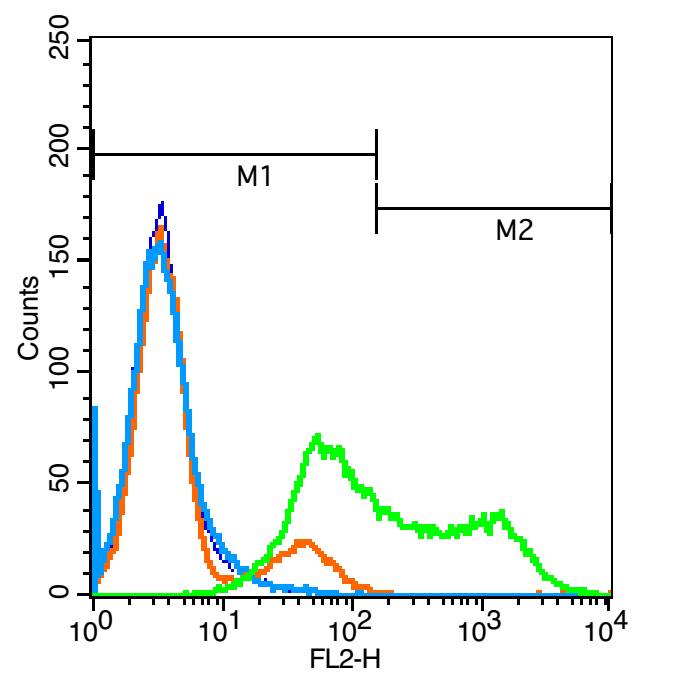
Rabbit Anti-phospho-ALK (Tyr1604)antibody
ALK (Phospho-Tyr1604); ALK(phospho-Y1604); p-ALK(Tyr1604); p-ALK(Y1604); ALK tyrosine kinase receptor precursor; ALK/EML4 fusion gene, included; ALK/NPM1 fusion gene, included; anaplastic lymphoma kinase (Ki-1); Anaplastic lymphoma kinase; Anaplastic lymp
View History [Clear]
Details
Product Name phospho-ALK (Tyr1604) Chinese Name 磷酸化间变型淋巴瘤激酶抗体 Alias ALK (Phospho-Tyr1604); ALK(phospho-Y1604); p-ALK(Tyr1604); p-ALK(Y1604); ALK tyrosine kinase receptor precursor; ALK/EML4 fusion gene, included; ALK/NPM1 fusion gene, included; anaplastic lymphoma kinase (Ki-1); Anaplastic lymphoma kinase; Anaplastic lymphoma kinase Ki 1; Anaplastic lymphoma kinase Ki1; Anaplastic lymphoma kinase p80 CD 246; CD246; CD246 antigen; EC 2.7.10.1 Ki 1; Ki1; NBLST3; Tcrz; TFG/ALK; ALK_HUMAN. literatures Product Type Phosphorylated anti Research Area Tumour Cell biology Chromatin and nuclear signals Neurobiology Signal transduction Apoptosis Growth factors and hormones Kinases and Phosphatases The cell membrane受体 Immunogen Species Rabbit Clonality Polyclonal React Species Human, (predicted: Pig, Guinea Pig, ) Applications ELISA=1:5000-10000 IHC-P=1:100-500 IHC-F=1:100-500 Flow-Cyt=1μg /test IF=1:100-500 (Paraffin sections need antigen repair)
not yet tested in other applications.
optimal dilutions/concentrations should be determined by the end user.Theoretical molecular weight 174kDa Cellular localization The cell membrane Form Liquid Concentration 1mg/ml immunogen KLH conjugated Synthesised phosphopeptide derived from human ALK around the phosphorylation site of Tyr1604: GH(p-Y)ED Lsotype IgG Purification affinity purified by Protein A Buffer Solution 0.01M TBS(pH7.4) with 1% BSA, 0.03% Proclin300 and 50% Glycerol. Storage Shipped at 4℃. Store at -20 °C for one year. Avoid repeated freeze/thaw cycles. Attention This product as supplied is intended for research use only, not for use in human, therapeutic or diagnostic applications. PubMed PubMed Product Detail This gene encodes a receptor tyrosine kinase, which belongs to the insulin receptor superfamily. This protein comprises an extracellular domain, an hydrophobic stretch corresponding to a single pass transmembrane region, and an intracellular kinase domain. It plays an important role in the development of the brain and exerts its effects on specific neurons in the nervous system. This gene has been found to be rearranged, mutated, or amplified in a series of tumours including anaplastic large cell lymphomas, neuroblastoma, and non-small cell lung cancer. The chromosomal rearrangements are the most common genetic alterations in this gene, which result in creation of multiple fusion genes in tumourigenesis, including ALK (chromosome 2)/EML4 (chromosome 2), ALK/RANBP2 (chromosome 2), ALK/ATIC (chromosome 2), ALK/TFG (chromosome 3), ALK/NPM1 (chromosome 5), ALK/SQSTM1 (chromosome 5), LK/KIF5B (chromosome 10), ALK/CLTC (chromosome 17), ALK/TPM4 (chromosome 19), and ALK/MSN (chromosome X).[provided by RefSeq, Jan 2011].
Function:
Neuronal orphan receptor tyrosine kinase that is essentially and transiently expressed in specific regions of the central and peripheral nervous systems and plays an important role in the genesis and differentiation of the nervous system. Transduces signals from ligands at the cell surface, through specific activation of the mitogen-activated protein kinase (MAPK) pathway. Phosphorylates almost exclusively at the first tyrosine of the Y-x-x-x-Y-Y motif. Following activation by ligand, ALK induces tyrosine phosphorylation of CBL, FRS2, IRS1 and SHC1, as well as of the MAP kinases MAPK1/ERK2 and MAPK3/ERK1. Acts as a receptor for ligands pleiotrophin (PTN), a secreted growth factor, and midkine (MDK), a PTN-related factor, thus participating in PTN and MDK signal transduction. PTN-binding induces MAPK pathway activation, which is important for the anti-apoptotic signaling of PTN and regulation of cell proliferation. MDK-binding induces phosphorylation of the ALK target insulin receptor substrate (IRS1), activates mitogen-activated protein kinases (MAPKs) and PI3-kinase, resulting also in cell proliferation induction. Drives NF-kappa-B activation, probably through IRS1 and the activation of the AKT serine/threonine kinase. Recruitment of IRS1 to activated ALK and the activation of NF-kappa-B are essential for the autocrine growth and survival signaling of MDK.
Subunit:
Homodimer. Homodimerizes when bound to ligand. Interacts with FRS2, IRS1, MDK, PTN and SHC1. Interacts with CBL, PIK3R1 and PLCG1.
Subcellular Location:
Cell membrane; Single-pass type I membrane protein. Note=Membrane attachment was crucial for promotion of neuron-like differentiation and cell proliferation arrest through specific activation of the MAP kinase pathway.
Tissue Specificity:
Expressed in brain and CNS. Also expressed in the small intestine and testis, but not in normal lymphoid cells.
Post-translational modifications:
Phosphorylated at tyrosine residues by autocatalysis, which activates kinase activity. In cells not stimulated by a ligand, receptor protein tyrosine phosphatase beta and zeta complex (PTPRB/PTPRZ1) dephosphorylates ALK at the sites in ALK that are undergoing autophosphorylation through autoactivation.
N-glycosylated.
DISEASE:
Note=A chromosomal aberration involving ALK is found in a form of non-Hodgkin lymphoma. Translocation t(2;5)(p23;q35) with NPM1. The resulting chimeric NPM1-ALK protein homodimerize and the kinase becomes constitutively activated. The constitutively active fusion proteins are responsible for 5-10% of non-Hodgkin lymphomas.
Note=A chromosomal aberration involving ALK is associated with inflammatory myofibroblastic tumors (IMTs). Translocation t(2;11)(p23;p15) with CARS; translocation t(2;4)(p23;q21) with SEC31A. [DISEASE] Note=A chromosomal aberration involving ALK is associated with anaplastic large-cell lymphoma (ALCL). Translocation t(2;17)(p23;q25) with ALO17.
Neuroblastoma 3 (NBLST3) [MIM:613014]: A common neoplasm of early childhood arising from embryonic cells that form the primitive neural crest and give rise to the adrenal medulla and the sympathetic nervous system. Note=Disease susceptibility is associated with variations affecting the gene represented in this entry.
Note=The ALK signaling pathway plays an important role in glioblastoma, the most common malignant brain tumor of adults and one of the most lethal cancers. It regulates both glioblastoma migration and growth.
Similarity:
Belongs to the protein kinase superfamily. Tyr protein kinase family. Insulin receptor subfamily.
Contains 1 LDL-receptor class A domain.
Contains 2 MAM domains.
Contains 1 protein kinase domain.
SWISS:
Q9UM73
Gene ID:
238
Database links:Entrez Gene: 238 Human
Omim: 105590 Human
SwissProt: Q9UM73 Human
Unigene: 654469 Human
Product Picture
Primary Antibody:Rabbit Anti-phospho-ALK (Tyr1604) antibody(SL3022R), Dilution: 1μg in 100 μL 1X PBS containing 0.5% BSA;
Isotype Control Antibody: Rabbit IgG(orange) ,used under the same conditions );
Secondary Antibody: Goat anti-rabbit IgG-PE(white blue), Dilution: 1:200 in 1 X PBS containing 0.5% BSA.
Bought notes(bought amounts latest0)
No one bought this product
User Comment(Total0User Comment Num)
- No comment



 +86 571 56623320
+86 571 56623320
 +86 18668110335
+86 18668110335

